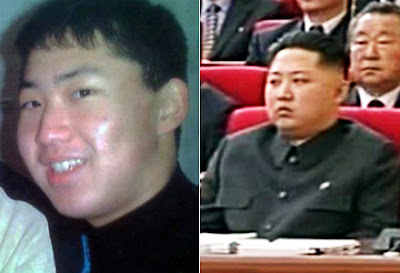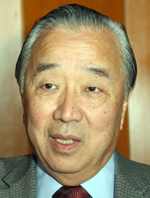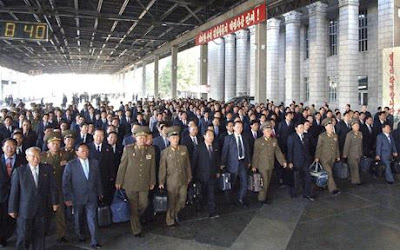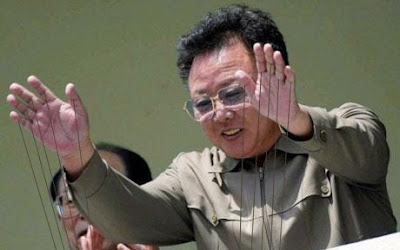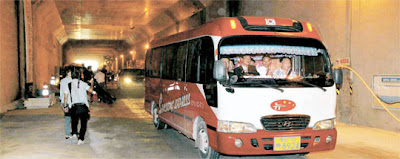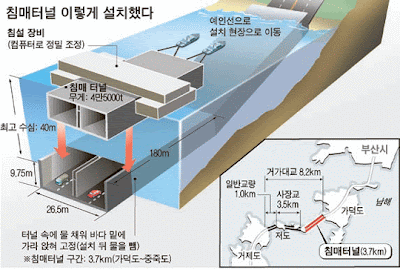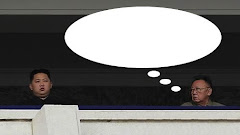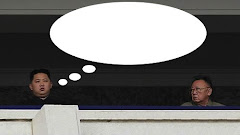Over at One Free Korea, a discussion of acceptance of the official findings of the
Ch'ŏnan sinking led me to offer up
the November 29, 1987, downing of KAL 858 as a far more glaring example of a somewhat flimsy case of North Korean malfeasance presented by South Korean authorities.
I had always thought the case of terrorist "Mayumi" (Kim Hyŏnhŭi; 김현희) and her older male accomplice having blown up the plane at the behest of then leader-in-waiting Kim Jong-il's was a little too quickly and too perfectly presented for my taste, and I had always suspected there were others who thought the same as I do. Certainly my reservations seemed to parallel those today who might believe that North Korea was probably responsible for the sinking of the
Ch'ŏnan but that the ROK government's body of evidence was less than a slam dunk.
I was asked
at OFK to lay out the case, but I've always been reluctant to get into it too much for a variety of reasons. Primary among them, my skepticism is purely speculative and to lay out the case would involve me playing devil's advocate at the risk of seeming to endorse that case. Second, were I to make a really convincing devil's advocate argument despite my own agnosticism on the matter (something I am scarily good at), then I may end up serving the interests of people trying to undermine the ROK itself (
chinboistas and the like).
[But of course,
if the KAL 858 incident really were engineered or staged, then the individuals and/or administration responsible (not the current ROK government) should be held accountable. It should be noted that the downing of KAL 858 is the primary incident that got North Korea put on the list of state sponsors of terrorism, and it is widely considered an act where Kim Jong-il proved his worth to eventually take over DPRK leadership from his aging father, Kim Ilsung, something that many have suggested presumed heir Kim Jong-un has had to do with the
Ch'ŏnan sinking.
If (and I stress the hypothetical nature of that conditional) KJI had
nothing to do with KAL 858, then we may have constructed a narrative of the Pyongyang regime that is based on a major falsehood. That wouldn't negate the horrors that we know the DPRK machine has inflicted on its people, but it would paint a picture of the Dear Leader that is quite different from that of a maniacal killer who takes down planes full of innocent people.]
But I am willing to at least list some of the things that don't pass the smell test. For starters, a mass murderer was let off. First her death sentence was commuted to life in prison, which was not much of a surprise. But then they actually
let Kim Hyonhui go — and did so very publicly — on the basis of her contrition and a newfound epiphany about the superiority of the South Korean system as it headed into free elections. I wrote about that in this post:
Her case underscores one of the failings of the South Korean judicial system, whereby the flimsiest of mitigating circumstances is used as a pretext for letting someone off easy or off the hook altogether. In this case, instead of the all-too-familiar "I was drunk" excuse, hers was "I was beautiful."
If you were in South Korea at the time (Kushibo was a teenager in Seoul in 1987), there was no escaping this obvious conclusion: The press and public, at a time when the former was much more tightly under government control, had rallied around this highly telegenic personality, who had been dubbed the Virgin Bomber. The thought of killing the beautiful instigator (despite her having apparently murdered 115 people) was anathema because she was a
.
As I wrote
here, there are enough other oddities to write a book. From what I'd read at the time, there were no nationalities besides ROK citizens who lost their lives (which would make it easy for a right-wing ROK government to fabricate a passenger list or silence calls for further investigation after the matter was officially settled).
Furthermore, I recall that no wreckage or debris was found except a lifeboat-type thing from the wing. By contrast, after the Soviets shot down
KAL 007 a few years earlier, there was a considerable amount of debris found across the East Sea/Sea of Japan, including human body parts and lots of shoes identified by family members as those of their loved ones.
A third curiosity was that although all the people on board the plane were ROK nationals, the two (ostensibly) Japanese passengers who ended up blowing up the plane didn't somehow stand out on the first two legs of the flight, not enough for it to raise a red flag that they had somehow not gotten back on board in Abu Dhabi.
But the real cause for skepticism comes when one considers the timing of the incident. KAL 858 was blown up just weeks before South Korea's first direct presidential election in decades, which was a forced concession by the former general who was running the country and his hand-picked successor (who eventually won). It was glaringly obvious that the ruling party wanted to scare the public into supporting a continuation of their hardline stance on North Korea, something which might be undermined if the rabble-rouser Kim Youngsam or the "closet communist" Kim Daejung (the two opposition candidates whose inability to form a unified front assured Roh Taewoo's win) were to take control of the Blue House.
To drive home the communist threat from up north, one of the networks on the night before the election made sure to screen
The Killing Fields, a 1984 film based on true events that chronicled one man's escape from Cambodia after the murderous (and communist) Khmer Rouge had taken over.
Though disruption of the December 1987 presidential election was
speculated as one reason for the bombing, President Chun Doohwan declared that the primary reason for the bombing was to
scare people off from the following year's Olympic Games —
ten months later.
I could go on. Korean media that night showed wailing relatives at Kimpo Airport almost immediately after the plane lost contact with Bangkok air traffic controllers, before its fate was even known. And though the terror act itself occurred in the
United Arab Emirates and the two apparent terrorists were traveling on fake
Japanese passports, "Mayumi" was handed over to
South Korean authorities with great speed. Those things, of course, mean nothing by themselves, but as part of the whole big picture, it just adds to that unlikely perfectness with which this entire incident was presented as a slam dunk.
What do I think
really happened? If pressed to decide one way or another, I think North Korea probably really did blow up this plane. Probably. The alternatives would have to be either South Korea killing its own citizens for propaganda purposes, or for the entire flight to have been fabricated (an actual plane going dark and landing in Korea with over a hundred accomplices to the fabrication, or an actual aircraft, perhaps one near retirement, being ditched after the accomplice passengers were safely deplaned; production of the Boeing 707 involved was from 1958 to 1979).
Frankly, I would
love to have any or all of these points skewered and dismissed in an accurate and informative way (and I would especially love to see a
believable slam-dunk case laid out that this was as we were told it was). In particular, if there were non-ROK citizen passengers who were killed, I'd like to know. If the plane was new or newish, that would also be of interest to me. And in particular, if there was considerably more wreckage and debris than the lifeboat, that could make a difference in the case. Much of this is reliance on memory of news reports back in the late 1980s, which is hard to bolster and refute for an incident that happened so long before the Internet took over our lives.
Sphere: Related Content



